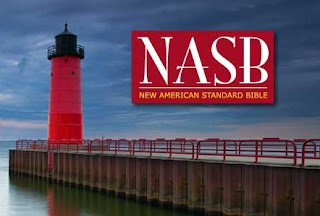STEPBible - Scripture Tools for Every Person - from Tyndale House, Cambridge
__
NASB Interlinear at STEPBible.org
The NASB (New American Standard Bible) can now be read as a word-by-word interlinear with Hebrew/Greek or along with other interlinear translations at STEPBible.org
The Lockman Foundation have generously allowed the NASB to join the other great Bibles at STEPBible.org along with full footnotes, cross references and their Greek & Hebrew tagging.
The NASB is one of the most accurate word-by-word translations. It attempts to use a standard English word for each Hebrew or Greek original. It also uses italics for words not represented in Hebrew or Greek, using the same strict criteria followed by the King James version. These standards do not always produce most natural English, but they make it ideal for study and getting to grips with what the original says.
All translations try to balance mirroring the language against trying to convey its meaning. The NASB style is perfect for interlinear displays, and this is probably why it has been our most requested Bible. Our grateful thanks to the Lockman Foundation for allowing this, and to Crosswire for the accurate Hebrew and Greek tagging.
Translation principles
Different translations are based on different principles. The word-by-word translation technique exemplified by the NASB is at one end of the spectrum while the idiomatic lively translation of the Message is at the other end.
The King James was remarkably successful at translating word-by-word though it sometimes had to use words invented by William Tyndale such as "scapegoat" and "atonement". Young's Literal Translation tried even harder to translate tenses and vocabulary according to very strict criteria, but most people feel this went too far. The New King James has remained with the textual decisions made by 17th century scholars, but the NASB is up to date with all the manuscripts discovered since then.
All translations have to be flexible to some extent, because languages don't work like algebra. For example you can't decide that Hebrew eretz = "earth" (i.e. the planet) because it is also used for a "land" (i.e. a country, like "eretz Israel"). Even Young's Literal Translation uses "land" (about 1450 times) and "earth" (about 670 times) – about the same as NASB. (see here).
Idioms can also cause problems, as you can imagine if you translate the French "tête–à–tête" into English. Translating it word-by-word as "head to head" makes it sound like a confrontation, so you have to use a more idiomatic translation such as "private conversation". Similarly the Bible has phrases such as "O Lord, why does your nose burn?" (e.g. Exo.32.11 – see also v.10, 11, 19, 22). All Bibles translate this idiomatically, e.g.: "why does your wrath burn hot?" (ESV); "… your anger burn" (NASB & NIV); "…lose your temper" (Message).
Tagging Greek and Hebrew
(The next couple of paragraphs are a bit nerdy, so you might want to skip to the final paragraph or just start playing with NASB. But these details are useful for understanding how translations link with the original language.)
Lining up Hebrew and Greek with the English is difficult even when the word meanings line up nicely. For example, the first word in the Bible (bereshit) has two parts: be = "in" and reshit = "beginning" – but there is nothing equivalent to our English word "the". So should bershit be linked with "In the beginning" (as done by Crosswire for NASB & KJV) or with "beginning" (as done by Tyndale House for ESV etc. - see here). Crosswire's method is more accurate and harder to implement, but it is impossible to be completely accurate. Tyndale House links the original word with the most significant English word – a method which we are now trying to automate to tag many more Bibles.
The NASB tagging is superior to the KJV tagging because it differentiates between identical Hebrew words with different meanings. These words were mixed together in Strong's lexicon. Tyndale House has edited these tags to make them conform with modern Hebrew lexicons by using BDB links (as explained here).
Best of the old and the new
The NASB module has both the best principles of the KJV word-by-word translation without obscuring the English, and also the best of modern scholarship in manuscripts and lexicography. Within STEPBible this forms an excellent basis for studying the Greek and Hebrew originals without being a language expert.
David Instone-Brewer
www.STEPBible.org is created and supported by Bible scholars at Tyndale House, Cambridge
with a great deal of help from volunteers and partnering by many organisations.



